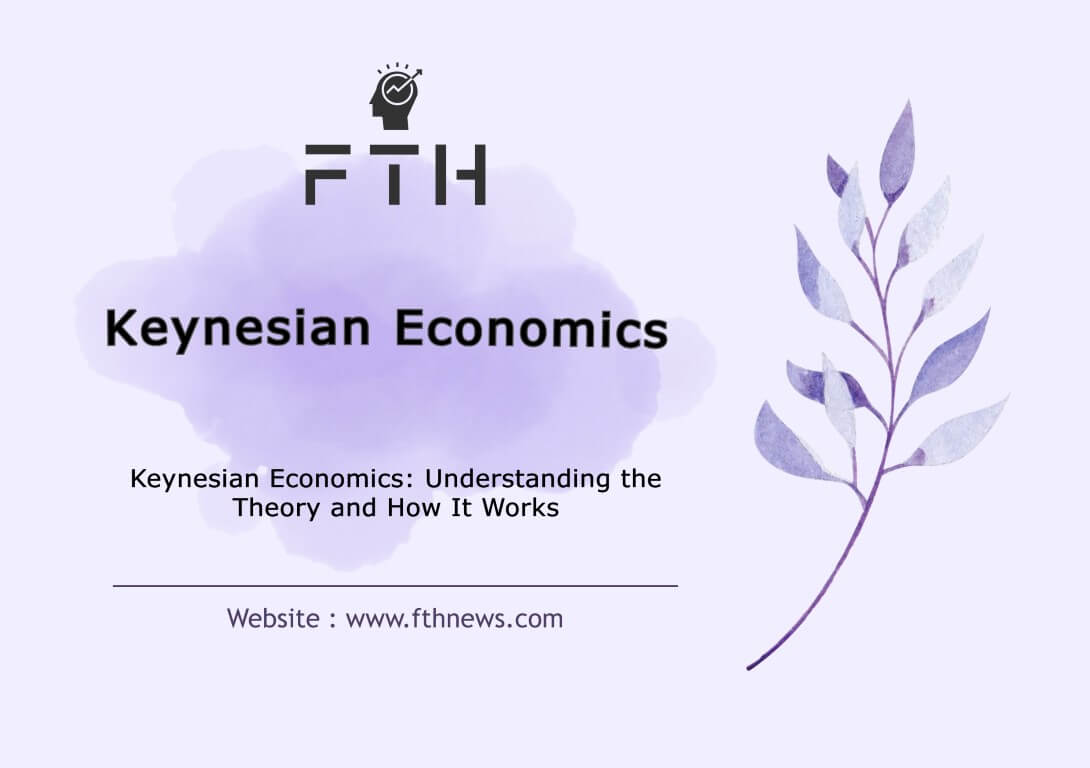
Keynesian Economics: Understanding the Theory and How It Works
Keynesian economics is an economic theory that analyzes the total expenditure within an economy and its impact on production and inflation. This theory was developed by the English economist John Maynard Keynes during the 1930 in response to the Great Depression in America.
Keynes proposed increased government spending and tax cuts to stimulate demand and lift the economy out of recession. As a result, the term ‘Keynesian economics’ came to refer to the concept that optimal economic performance could be achieved by influencing aggregate demand through government economic stabilization activities and the adoption of interventionist government policies in the economy. Keynesian economics is often categorized as a ‘demand-side’ theory that focuses on short-term changes in the economy.
John Maynard Keynes: The Economist Who Reshaped Economic Thinking
John Maynard Keynes, born on June 5, 1883, in England, emerged as one of the most influential economists of the 20th century. Hailing from a middle-class background, he embarked on a remarkable academic and career journey that left an indelible mark on the world of economics.
After his secondary education, Keynes attended Eton University and then pursued further studies at Royal College, Cambridge, in 1902. His early career saw him as a part-time employee in the India Department of the British Ministry of Defense. However, it was at Cambridge where Keynes truly began to make his mark. In 1909, he returned to Cambridge and assumed the role of a senior associate professor. By 1911, he was also the editor of an economic journal.
Keynes’s career took a turn during World War I when he worked in the British Treasury. Following the war, he was entrusted with leading the British Treasury’s delegation to the Paris Peace Conference. In 1919, he became the representative of the Minister of Finance in the Supreme Economic Council of England. However, his ideas on how to receive war reparations from the German government clashed with the British authorities, leading to his resignation from the position.
In 1925, Keynes married Lydia Lopokova, a Russian ballerina known for her artistic talent despite limited formal education. Keynes cherished her free-spirited nature.
Keynes’s most enduring contribution to economics came in 1936 with the publication of his magnum opus, “The General Theory of Employment, Interest, and Money.” This book reshaped economic thinking and remains one of the most influential economic texts of the 20th century.
Unfortunately, Keynes battled heart disease, which began to significantly affect his health in 1937. He passed away on April 20, 1946, at his country house in Tilton, Sussex.
Important Principles of Keynesian Economics
These principles serve as the cornerstone of Keynesian economics, guiding the development of economic policies with the overarching goal of achieving economic stability and sustainable growth.
Aggregate Demand and Economic Decisions
Keynesian economics is grounded in the belief that aggregate demand, influenced by both public and private economic decisions, is a fundamental driver of economic outcomes. This principle underscores the idea that the combined spending of households, businesses, and the government significantly shapes the overall performance of the economy.
Effects on Real Production and Employment
A central tenet of Keynesian economics is that changes in total demand, whether anticipated or unexpected, have substantial effects on real production and employment. Keynes argued that fluctuations in demand can lead to significant swings in economic activity, impacting employment and output. This principle places primary emphasis on real economic variables rather than on prices.
Price and Wage Rigidity
Keynesians contend that prices, particularly wages, tend to adjust slowly in response to changes in supply and demand. This rigidity can result in periodic shortages and surpluses within the economy. Keynesian theory posits that such price and wage stickiness contributes to economic instability, necessitating government intervention to stabilize the economy.
Normal Level of Unemployment
Challenging classical economic thought, Keynesians argue that the normal level of unemployment is not ideal. They assert that unemployment is largely dependent on total demand, and prices adjust gradually. This principle challenges the notion that a certain level of unemployment is necessary for a well-functioning economy, emphasizing the importance of managing aggregate demand to reduce unemployment.
Stabilizing Economic Policies
Most Keynesian economists advocate for active government policies designed to stabilize the economy and mitigate periodic business fluctuations. These policies may encompass fiscal measures, such as government spending and taxation adjustments, and monetary policies like changes in interest rates. The overarching goal is to counteract economic downturns and maintain steady economic growth.
Balancing Unemployment and Inflation
Within the Keynesian framework, there are differing views on policy priorities. Some Keynesian prioritize addressing unemployment and emphasize policies aimed at boosting employment. Others place a greater focus on controlling inflation, especially in situations where rising prices pose a significant threat to economic stability. The approach may vary depending on prevailing economic conditions and policymakers’ assessments.
Keynesian Economics vs. Classical Economic Thought
“Keynesian economics diverges from classical economic thought, which held that cyclical fluctuations in employment and economic output would be smooth and self-correcting. According to classical theory, if aggregate demand were to decline in the economy due to weaknesses in production and employment, prices and wages would fall significantly. This, in turn, was expected to encourage employers to invest more in capital assets and hire additional workers, leading to job creation and economic growth.
However, the profound and severe impact of the Great Depression of 1929 challenged this classical theory. In his groundbreaking work, ‘The General Theory of Employment, Interest, and Money,’ along with other books and articles, Keynes argued that structural inflexibil and unique aspects of a market economy could exacerbate economic weakness and cause a drop in aggregate demand.
For instance, Keynesian economics rejects the notion that lowering wages alone can restore full employment. This is because employers are unlikely to hire more workers for goods that lack demand and aren’t selling. Similarly, during weak economic conditions, firms may reduce their investment in capital assets rather than seizing the opportunity to invest in new plant and equipment at lower prices, which in turn can lead to reduced wages, increased public expenditure, and unemployment.
Keynesian Economics and the Great Depression
Keynesian economics, often termed “depression economics,” emerged during a time of global economic turmoil, with the Great Depression casting a long shadow over the world.
John Maynard Keynes, the architect of this economic theory, penned his groundbreaking 1936 work, “The General Theory of Employment, Interest, and Money,” against the backdrop of the Great Depression. This period of unprecedented economic crisis challenged conventional wisdom, particularly classical economic theories that assumed the self-correcting nature of the economy.
Classical economics posited that cyclical fluctuations in employment and economic output would naturally self-adjust. If aggregate demand dipped due to weakened production and employment, classical theory held that prices and wages would decline sharply. Such declines were believed to spur employers to invest in capital assets and hire more workers, ultimately fostering economic recovery.
However, the Great Depression defied this classical notion. Production remained stagnant, and unemployment rates remained stubbornly high. This crisis prompted Keynes to rethink the fundamental principles of economics. He contended that structural and specific characteristics of market economies could exacerbate economic weaknesses, leading to a fall in aggregate demand.
Keynes challenged the idea that reducing wages alone could restore full employment, arguing that employers wouldn’t hire more workers when demand for goods was low and stagnant. Additionally, during economic downturns, firms might hesitate to invest in capital assets, even as prices fell, contributing to reduced wages and increasing the government’s role in addressing unemployment through public expenditure.
Keynesian Economics:
Keynesian economics rejected the concept of a naturally self-adjusting market equilibrium. Keynes believed that, once a recession took hold, the pervasive fear and pessimism among businesses and investors became self-fulfilling, prolonging the economic downturn. To counteract this, Keynes advocated for counter cyclical fiscal policies. He proposed that during economic downturns, the government should increase its spending and reduce taxes, running budget deficits to compensate for decreased private sector investments, stimulate consumer spending, and stabilize aggregate demand.
Keynes’s critique extended to government policies of his time, where increased welfare spending and higher taxes to balance budgets were seen as ineffective in stimulating the economy. He argued that such measures discouraged consumer spending, thereby leaving the economy stagnant.
In response, Keynes recommended that governments increase their spending and reduce taxes to reduce budget deficits, thereby boosting consumer demand, stimulating economic activity, and reducing unemployment.
Keynes also cautioned against excessive saving, emphasizing its potential harm to the economy. He believed that stagnant money in savings accounts reduced the funds available for driving economic growth. Consequently, he advocated for policies aimed at preventing severe economic depressions.
Despite criticisms of Keynesian economics, particularly by those who believed in the self-regulating nature of markets, Keynes’s work was rooted in the reality of the Great Depression. He was less optimistic about the market’s inherent ability to restore equilibrium during such crises, contending that governments, through active intervention, were better positioned to create stable and robust economies.
Keynes Consumption Theory: The Absolute Income Hypothesis
John Maynard Keynes introduced the concept of the consumption function in his landmark work, “The General Theory,” published in 1936. This theory, often referred to as the Absolute Income Hypothesis, has since played a pivotal role in macroeconomic analysis.
Keynes posited that various factors influence individuals’ consumption decisions, with income being the most significant determinant in the short term. Notably, he believed that the interest rate did not play a substantial role in shaping consumption decisions, which diverged from classical economic perspectives that suggested a high interest rate would boost savings and reduce consumption.
In the Absolute Income Hypothesis, Keynes asserted that individuals, on average, tend to increase their consumption as their income rises. However, the increase in consumption is not proportionate to the increase in income. In simpler terms, as income grows, the ratio of consumption increase lags behind the income increase. This implies that the average propensity to consume is downward-sloping.
Keynes further introduced the idea that savings can be considered a form of luxury goods. In this context, when people experience an increase in income, the wealthy are expected to save a higher percentage of their income compared to those with lower income levels. As a result, the central focus of Keynes’ income theory revolves around addressing the phenomenon of decreasing average consumption desires.
Keynes’ Absolute Income Hypothesis fundamentally challenged classical economic thought, which emphasized the role of interest rates in influencing savings and consumption decisions. Instead, he directed attention to the immediate impact of income changes on consumption behavior. This concept became a cornerstone of Keynesian economics and continues to influence contemporary macroeconomic analyses and policy discussions.
The Origins of the Keynesian School: A Brief Overview
The Great Crisis of 1929-1933: The catalyst for the emergence of the Keynesian school of thought was the Great Depression, a devastating economic crisis that gripped the world from 1929 to 1933. This unprecedented downturn left governments, economists, and policymakers in search of a new economic approach that could not only explain the crisis but also offer effective solutions to address it.
Neoclassical Theory’s Inadequacy: The prevailing neoclassical economic theory, which emphasized the self-correcting nature of markets, proved inadequate in explaining the complexities of the Great Depression. Neoclassical economics couldn’t account for the high levels of unemployment, the sharp decline in investment, and the widespread stock market crashes that characterized the crisis. This inadequacy created a demand for alternative economic theories that could provide more comprehensive insights into the crisis.
Keynes’s Practical Success: John Maynard Keynes’s groundbreaking ideas, as outlined in his seminal work “The General Theory of Employment, Interest, and Money” published in 1936, offered a new economic paradigm. Keynesian economic principles, rooted in government intervention and the management of aggregate demand, were put into practice during the Great Depression. Keynes’s policies aimed at reviving employment and production, and they showed practical success. This tangible impact on mitigating the effects of the economic downturn earned Keynes a stamp of approval from a broad spectrum of critics, at least in the short term. The Keynesian school thus gained recognition for its ability to address the real-world economic challenges posed by the Great Depression.
The Keynesian revolution marked a significant shift in economic thinking, emphasizing the importance of active government policies to manage economic fluctuations, stabilize employment, and ensure sustained economic growth. It left an enduring legacy in macroeconomics and policy discussions, influencing how governments approach economic crises and manage their economies.
Keynes’ Solution for Achieving Full Employment
John Maynard Keynes proposed a comprehensive solution to address the challenge of unemployment and achieve full employment. His approach focused on the role of government intervention in stimulating economic activity. Here’s an elaboration of Keynes’ solution:
Increase Total Demand:
Keynes argued that the key to achieving full employment was to boost total demand in society. He believed that when total demand surpassed the level of potential production, it would lead to increased economic activity and reduced unemployment. To accomplish this, the government could employ two general methods:
a. Expansionary Fiscal Policies: One approach involved the government increasing its expenditures. This could include investments in infrastructure, public projects, and various government programs. By injecting more money into the economy through government spending, total demand would rise, leading to increased production and employment.
b. Expansionary Monetary Policies: Another method focused on reducing interest rates by increasing the money supply. Lower interest rates could businesses to invest in capital projects, as borrowing costs decreased. Simultaneously, households would be encouraged to spend more due to reduced costs associated with borrowing and higher consumer confidence. This, in turn, would lead to greater economic activity and employment.
Government as a Regulator:
Keynes envisioned the government as both a direct and indirect regulator of market activities. By actively adjusting fiscal and monetary policies, the government could address imbalances and inadequacies in the market, preventing economic downturns and unemployment.
Income Redistribution:
Keynes’ theory of consumption highlighted the significance of income redistribution as an effective economic policy. By levying taxes on the wealthy and redistributing income to the poor, the government not only promoted social justice but also increased overall consumption in society. Keynes argued that an additional monetary unit in the hands of the rich tended to result in increased savings, which did not contribute as directly to total demand. However, when the same monetary unit was redistributed to lower-income individuals, it led to increased consumption, thereby enhancing total demand.
Keynesian economic policies were perceived as a remedy for short-term economic challenges. They addressed market system deficiencies and social and economic injustices by actively promoting both economic growth and social equality. Keynes’ proposals were instrumental in shaping government economic policies in many countries and continue to influence macroeconomic discussions and policy decisions today.














